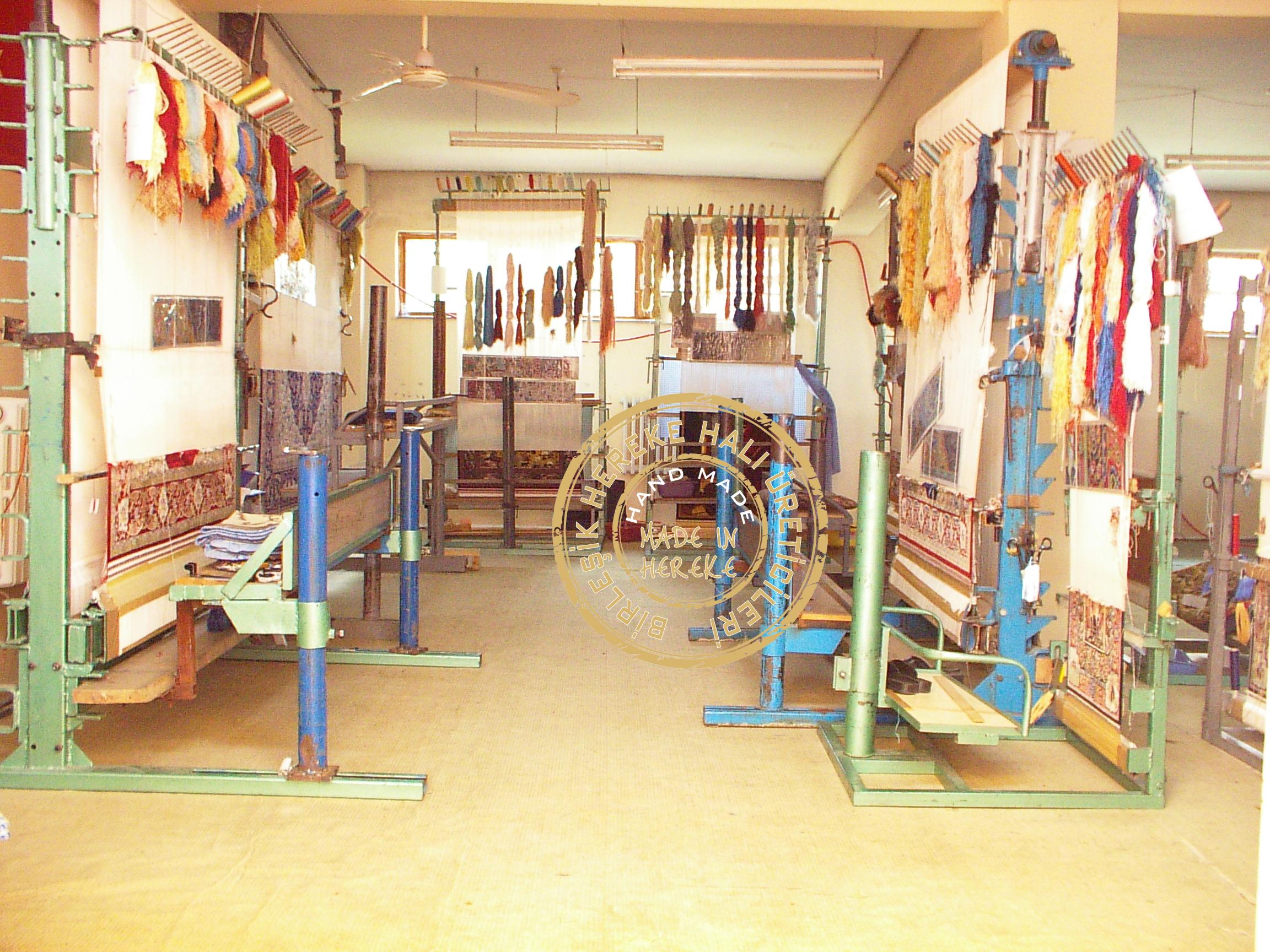ABOUT US

HEREKE HALILARI
En eski örneklerine saraylarda rastladığımız Hereke halılarının en önemli özelliği, inceliği ve bu inceliği sağlayan düğüm sayısı ile tekniği.
Dünyada bilinen en eski halı, Orta Asya’da bulunan kare desenli bir pazirikti. Bugün; St. Petersburg’taki Hermitage Müzesi’nde orijinal haliyle korunan halı, Türklerin Kavimler Göçü yıllarındaki göçebe alışkanlıklarını ve atlarına olan bağlılıklarını açıkça simgeliyordu. Pazirikten bugüne halılar, yüzyıllar boyunca hayatın tanımı oldu. Sadece ihtiyaçları karşılamakla kalmadı; insanı insan yapan tüm duygular, renklerle sembollerle ilmek ilmek dokundu… Bugün dünyanın en ince ve değerli halıları olarak tanınan ‘Hereke halıları’ dokuma tarihinin olgunluk noktasıdır. 19. yüzyıl halı sanatı içinde önemli bir yere sahip, saray ve çevresi için özel olarak dokunan Hereke halıları, Anadolu halılarından aldığı geleneği geliştirmiş; hem desen tasarımlarıyla hem de dokuma tekniğiyle bu sanatı daha üst seviyelere taşımıştır.
SARAYLARIN HALILARI HEREKE’DEN
Bugün en eski örnekleri Topkapı Sarayı Müzesi’nde ve birkaç sarayda bulunan Hereke halılarının tarihi, 1843’te, Sultan Abdülmecid döneminde Osmanlı sanayisinin ilk modern fabrikalarından biri olarak kabul edilen Hereke Fabrika-i Hümâyûnu’nun kurulmasıyla başlar. Bu fabrika; başta, saraylar olmak üzere dönemin eşraf evlerinin döşemelik kumaş, perde ve halı ihtiyacını karşılamak üzere kurulur. 1878’de bir yangınla kullanılamaz hale gelen fabrika, 1882’de yeniden açılır. Sultan II. Abdülhamid devrinde sarayların ihtiyacını karşılamak üzere 1891 yılında halı üretimine başlar. İlk ürünler Manisa ve Gördes çevresinden getirilen ustaların önderliğinde oluşturulur. Zamanla dokumaların çeşit ve miktarı artırılır; kalite açısında Avrupa halıları ile rekabet edebilecek düzeye getirilir. Hereke halıları aynı zamanda Osmanlı İmparatorluğu’nun ilk ihraç ürünlerindendir. Avrupa sarayları onunla süslenir. Girdiği tüm uluslararası fuarlarda birincilik ödülleri ve başarı madalyaları alır.
Aynı zamanda Herekeli ustaların oluşturduğu bir atölye de Dolmabahçe Sarayı’nın bahçesine kurulur. Hereke’deki fabrikanın özel bir atölyesi olarak kullanılan ve Hereke Dokumahanesi olarak adlandırılan bu büyük yapıda da sarayın ihtiyacı olan ipekliler dokunur.
SANTİMETREKAREDE 100 DÜĞÜM
Dokuma malzemesi olarak çok ince iplik ve ipeğin kullanıldığı Hereke halılarını diğer halılardan ayıran en önemli özellik örme tekniğidir. Hereke halısının uzun ömürlü olmasının nedeni ‘Gördes düğümü’ diye de bilinen ‘çift düğüm’ tekniği ile dokunmasıdır. Ustaların diğer tüm halıları inceleyerek, sabırla keşfettikleri bir tekniktir bu.
Santimetrekaredeki düğüm sayısının artması, biçimlendirilen motiflerin detaylandırılmasını da beraberinde getirir. Sonuçta olağanüstü incelikte ve hayal gücünün ötesinde motifler taşıyan sanat eserleri çıkar ortaya.
İpek bir Hereke halısında, bir santimetrekareye düşen düğüm sayısı şaşırtır insanı. Ortalama 10×10, yani 100 düğüm bulunur. Bu, her santimetrekare için dikeyde ve yatayda 10 düğüm demektir ki; gözün algısını zorlar. Kimi Hereke halısında düğüm sayısı 12×12, 14×14; hatta 40×40’dır, ki bu halılar dünyanın en ince halılarıdır. Yetkin bir dokuma ustası, bir milyon düğümden oluşan bir halıyı en az bir yılda yaratır.
Kaliteli işçiliği ve özgün örnekleriyle hem Osmanlı hem de Avrupa saraylarını süsleyen Hereke halıları bugün de korunuyor ve yaşatılıyor. Sanatseverler koleksiyonlarındaki zenginliği, sahip oldukları Hereke halılarının çokluğuyla, bazen de niteliğiyle ölçüyorlar.
Amaç ve kaynak hep aynı: Paylaşılan zevk… Sınırları kaldıran Hereke zevki kuşaklar boyunca süregeldi. Anlaşılan o ki; dokuma ustaları ve sanatseverleriyle yüzlerce yıl daha yaşayacak.
HEREKE CARPETS
Hereke carpets, the oldest examples of which are found in palaces, are known for their fine texture and the knotting technique that makes it possible.
The oldest known carpet in the world is a square Pazirik that was found in Central Asia. This carpet, which is preserved today in mint condition in St. Petersburg’s Hermitage, clearly symbolizes the nomadic lifestyle of the Turkic tribes and their dependence on horses. From the Pazirik to the present, life has defined carpets. Not only fulfilling everyday needs, they have at the same time reflected the full gamut of human emotions woven into their texture in colors of every hue.
Turkish ‘Hereke carpets’, which are regarded today as among the finest and most valuable carpets in the world, represent the apotheosis of the history of weaving. Occupying a central place in the 19th century art of the carpet, Hereke carpets were woven specially for the palace and its circle.
As an adaptation and extension of the traditional Anatolian carpet, they raised this art to even greater heights through their patterns as well as their weaving technique.
PALACE CARPETS FROM HEREKE
The history of Hereke carpets, the oldest examples of which are found today in the Topkapi Palace Museum and a few other palaces, begins with the establishment in 1843 of the Imperial Carpet Factory at Hereke, regarded as one of the first modern factories in Ottoman industry, during the reign of Sultan Abdülmecid. This factory was set up to provide fabrics, draperies, carpets and other textiles for the homes of contemporary notables, primarily the palaces. Damaged by fire in 1878, it was reopened in 1882 and in 1891 began carpet production to meet the needs of the imperial palaces during the reign of Abdülhamid II. Its first products were developed under the leadership of master weavers brought from the regions of Manisa and Gördes.
As the number and variety of carpets produced increased over time, Hereke carpets also became the Ottoman Empire’s first export products. Adorning the palaces of Europe, they captured top place in every international competition they entered and received medals of success.
Another workshop developed by the masters of Hereke was that set up in the garden of Dolmabahçe Palace. Here, in a large building known as the ‘Hereke Weaving Workshop’ which operated as a special offshoot of the factories at Hereke, silk carpets were woven to supply palace needs.
100 KNOTS PER SQUARE CENTIMETER
Their weaving technique, in which the finest threads and silk are employed, is what distinguishes Hereke products from other carpets. The ‘Gördes knot’, which gives the Hereke its long life, is a technique known as ‘double knotting’, a technique which the Hereke masters invented following patient examination of all other carpets.
Increasing the number of knots per square centimeter also meant a further refinement of detail in the motifs used, with the result that virtual works of art emerge of astonishing refinement with motifs that stagger the imagination. The number of knots per square centimeter in a silk Hereke carpet confounds the human mind: on average 10×10, in other words 100 knots! This means ten vertical times ten horizontal knots in every square centimeter, which are impossible to discern with the naked eye. And in some Hereke carpets the number of knots goes as high as 12×12, 14×14, even 40×40, these latter of course being the finest carpets in the whole world. An experienced master weaver takes at least one year to produce a single carpet consisting of a million knots.
Adorning palaces both Ottoman and European with their quality workmanship and unique designs, Hereke carpets continue to be preserved today. Indeed, art lovers often judge the quality and richness of a collection by the number of Hereke carpets it contains. Perhaps there are fewer looms in use than before, but one thing never changes: “There is no compromising of quality,” the Hereke carpet-makers assure us.
